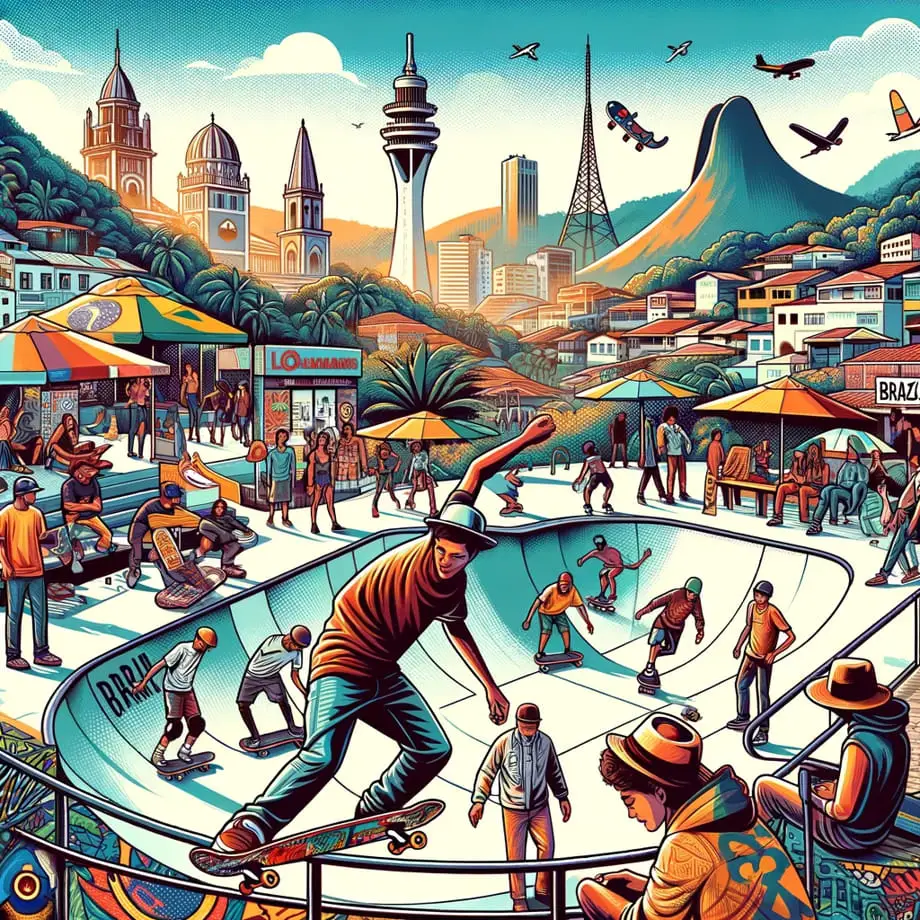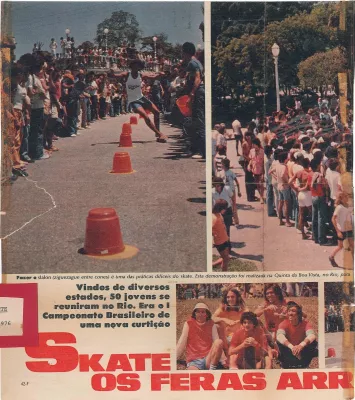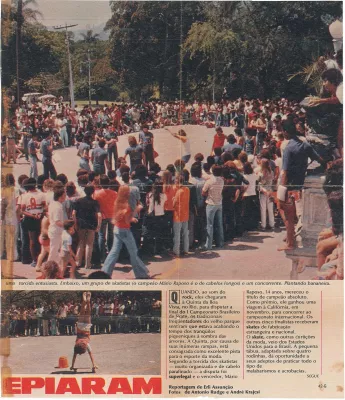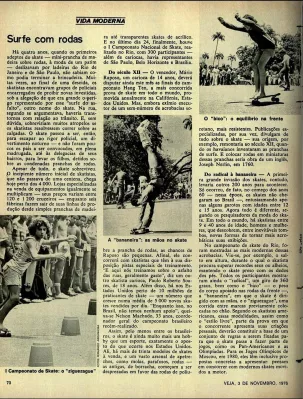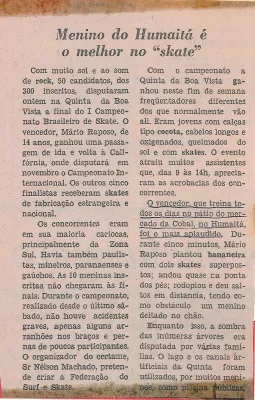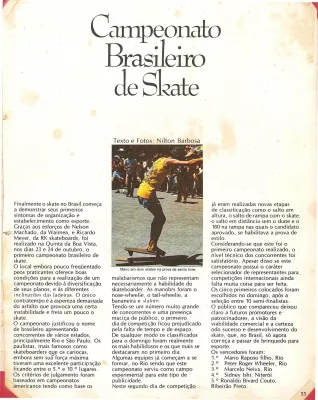The History of Skateboarding in Brazil
The history of skateboarding in Brazil emerged in the second half of the 1960s, the crowd that started venturing on the sidewalks and cobblestones was influenced by the magazine surfer. The skate of the time was called surfinho, making a clear reference in the relation between the maneuvers in the waves of the sea and those of the asphalt. In the early years, it was a very improvised thing, some wood was used, with roller skate wheels nailed.
Cesinha Chaves tells that her trajectory in the History of skateboarding in Brazil began in 1968, her two passions were a 9'8 ”São Conrado, and a 24” Nash Sidewalk Sulfboards. At the time, Cesinha worked with surfing in the city of Saquarema, and on one of his trips to Rio de Janeiro he acquired a skateboard with clay wheels (Clay Weels) and laminated wood, from one of the sons of the North American ambassador in Rio. The “boy” used to practice the sport in the fortress of São João, in Urca, while Cesinha preferred to use his skateboard in Arpoador, one of the most important points in the history of surfing in Rio de Janeiro, where he warmed up and then fell into the sea with his surfboard.
History of surfing in Rio de JaneiroOther prominent figures in the introduction of the sport in Brazil are the brothers Marcelo and Luizito Neiva, Marcelo 'Bruxa', Alexandre 'Gordo' and Erivaldo de Souza 'Maninho', who with their Cadillac Kid descended the hills of Maria Angélica and Cedro in the Jardim Botânico neighborhood in Rio de Janeiro. In São Paulo, skaters' favorite spot was the Sumaré and Morumbi slopes.
The first championships in the history of skateboarding in Brazil
One of the milestones in the consolidation of skateboarding as a sports activity was the first major championship held at Quinta da Boa Vista (Rio de Janeiro), in October 1976. There were still no suitable tracks for the sport, and the competition took place on the streets. Among the maneuvers, there was the classic dug in the asphalt (with the skater crouching to the maximum in performance poses), handstand (banana on the skate), nose-wheelis (bow bearing on two skateboards), high jump (high jump ), barrel jump and footwork.
Skate tricksAs we can see in the image, the use of sneakers was not mandatory for skaters, and in most cases, both sportspeople and the public wore colorful shirts, short shorts, and not too wide. The first championship was accompanied by two important innovations for the sport, they are: the Tracker Trucks axis, which, wider, enabled better curves; and the Road Rider wheels that replaced their loose ball bearings with their self-locking nut bearings.
In the following year, the first Championship of the History of skateboarding was held in Brazil, with a national dimension, organized by Waimea Surf Shop, in the Federal Club of Rio de Janeiro. The championship had 34 entries, divided into two categories, the senior, won by Flávio Badenes, and the junior, won by Mário Raposo. Most of the skateboards were imported, and of different brands: Bahne, Super Surfer, Cadillac, Hang Tem; but there were also national brands, such as Torlay, Bandeirante and RK.
Skaters dominate the streets and rinks
With the growth of skateboarding and the lack of appropriate spaces, young people ended up looking for the best places on their own, occupying the streets with their tribes, style, and outgoing style on wheels. At that time, the non-specialized press began to report on events involving the sport, and a fact reported by Manchete magazine in 1976 showed the attempt by police to prevent the practice of sports in the Morumbi neighborhood, in São Paulo.
At the same time that the sport was frowned upon in some regions of the country, in others it gained appropriate spaces, as in Nova Iguaçu (Rio de Janeiro), where the first skate park in Latin America was inaugurated in 1976, which it had two bowls with a 20 ° inclination. The new structure led to a national revolution in the practice of sport, which started to put aside the freestyle and started to incorporate the ‘bowlriding’ style. The following year, the track hosted the first skateboarding championship in the history of skateboarding in Brazil. The architecture of the track was strongly influenced by Skateboarder Magazine, which showed on its pages how the sport was practiced in the United States, on tracks, or empty pools, with maneuvers such as: berts, strikes, one and a half (360º and a half in the transition) and a lot of speed.
New leads were emerging throughout the country: Clube Regatas Flamengo (Rio de Janeiro) and Alphaville (São Paulo), in 1977; Wave Park (Santo Amaro), Jacarepaguá (Rio de Janeiro), Mooca (São Paulo) and Jurêre (Santa Catarina), in 1978; among others. And there was a whole media specialized in sports: a cable TV channel, Jornal do Skate, Wave Park, Brasil Skate Magazine and Esqueite Magazine. The late 1970s marked the apogee of the sport, which now has more infrastructure and improvement of equipment, means of dissemination and organization of championships.
The first great fall in the history of skateboarding in Brazil
But a few years later, the sport suffered a declining public, closed lanes and decreased investments, the crisis favored freestyle, and the resurgence of the sport's breath would happen a few years later, starting in 1984. Contributing to the decline in the skateboarding, the new national fashions, the bike and the skates, started to attract the attention of the public and investors, who interested in making a profit, started to invest in the production of articles for the new sports. Another symbol of the cooling of the skate fever, was the fact that Revista Skateboarder’s Action Now15, stopped publishing articles exclusively about skaters, and skate started to share the pages with martial arts, surfing, BMX, among others.
Even so, the true lovers of the sport did not abandon the maneuvers on the asphalt, with the closure of the Waves Parks, a landmark of the vertical modality, the freestyle style gained new breath. With the inauguration of the Wave Cat complex, in São Bernardo do Campo, in 1980, old and new skateboarders found an exclusive space for their maneuvers. Names like Marcelo Neiva, Ricardo 'Barbeiro', Cesinha Chaves, Alexandre 'Minhoca', 'Aladim', 'Vitchê', Tchap Tchura, formed the first generation, while new practitioners, such as Osmar Fossa, Sérgio 'Negão', 'Fraldão ', George Rotatori, Ari Jumonji, Edu Britto,' Anjinho ', Felipe' Banana ', guaranteed the national continuity of the passion for the sport. The early 1980s had few championships, the main ones being the inauguration of Wave Cat, in 1981, at Itaguará Country Club, in Guaratinguetá, and Dowhill and Longboard, in Morumbi, in 1982. Still in the year From 1982, a Freestyle Championship took place, at the Ibirapuera pavilion, where the first approaches with the SkateStreet style took place, which would mark the decade, with its guide maneuvers.
Skateboard gains new breath in the national taste
In 1983, the first skate in the history of skateboarding in Brazil, Mad Rats, was created and designed by Marcio Tanabe and Duarte Yura, who also practiced the sport. The number of championships has been increasing throughout the decade, and in 1984, Powell Peralt a skateboard video clips appeared.
The way people skated around the world started to be publicized through these videos, and wooden halfpipes became the solution for those who intended to ride upright, and anywhere was a place for skateboard, vacant lots and backyards. started to house clues. The sport gained even more repercussion with the launch of the program “Vibração”, in Rio de Janeiro, presented by Cesinha Chaves.
In that same year, 1984, the first specialized skate magazine of the 1980s, Overall, appeared in São Paulo, and in 1986, the second magazine, Yeah! The expansion of the sport continues, and has a new milestone in the history of skateboarding in Brazil, the strengthening of the largest skateboard manufacturer, H-Prol and the foundation of the Union of Skateboarders and Entrepreneurs. In 1988 the Brazilian Skate Union and the Sea Club Overall Skate Show (simultaneous skate and show) took place, with the participation of international guests, as the sport grew, an unusual event happened.
Mayor Jânio Quadros forbids the practice of sports in São Paulo, in 1988. But that did not stop the sport from continuing to grow, and the following year was marked by a record of events, with emphasis on the Itaú Skate Cup, which it was attended by Americans Micke Alba, Mark “Gator”, Joe Johnson and Ken Park. These were the main points of the scenario that originated the third generation of the sport, formed by Márcio 'Tarobinha', Ricardo 'Pingüim', Rodil de Araujo Jr. 'Ferrugem', Fabio 'Chupeta', Rodrigo 'Digo' Menezes, Alexandre Viana, Marcelo 'Just. The new practitioners joined Freestyle in Street mode, and started the process that gave the “face” of the sport today.
Frequently Asked Questions
- How has skateboarding culture evolved in Brazil, and what impact has it had on the global skateboarding community?
- Skateboarding in Brazil evolved from a niche sport to a mainstream phenomenon, heavily influenced by its vibrant street culture and beach lifestyle. It has produced world-renowned skateboarders and contributed to the global skateboarding community with its unique style and skate spots.
- How has skateboarding culture evolved in Brazil, and what impact has it had on the country's sports culture?
- Skateboarding in Brazil has evolved from a niche activity to a widely recognized sport. It's impacted Brazil's sports culture by introducing a new realm of urban sports, producing world-class skateboarders, and influencing lifestyle and fashion.

